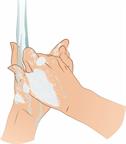Home Oxygen Use, Adult
When a medical condition keeps you from getting enough oxygen, your health care provider may have you use extra oxygen at home. Your health care provider will let you know:
Home oxygen can be given through:
A mask. This covers the nose and mouth or covers a tracheotomy tube.
A nasal cannula. This is a device or tube that goes in the nostrils.
A transtracheal catheter. This is a small, thin tube placed through the neck and into the windpipe (trachea).
A breathing tube (tracheostomy tube) that is surgically placed in the windpipe.
These devices have tubing that connects to an oxygen source, such as:
A tank. Tanks hold oxygen in gas form. The tank must be replaced when the oxygen is used up.
A liquid oxygen device. This holds oxygen in liquid form. This must be replaced when the oxygen is used up.
An oxygen concentrator machine. This filters oxygen in the room. It uses electricity so you must have a backup oxygen tank in case the power goes out.
Work with your health care provider to find equipment that works best for you and your lifestyle.
What are the risks?
Your health care provider will talk with you about risks. These may include:
Fire. This can happen if the oxygen is exposed to a heat source, flame, or spark.
Injury to the skin. This can happen if liquid oxygen touches the skin. Pressure sores may occur if the oxygen tubing presses on the skin.
Damage to the lungs or other organs. This can happen from getting too little or too much oxygen.
Supplies needed:

To use oxygen, you will need:
A mask, nasal cannula, transtracheal catheter, or tracheostomy.
An oxygen tank, a liquid oxygen device, or an oxygen concentrator.
Your health care provider may recommend:
How to use oxygen

You will be shown how to use your oxygen device. Follow the instructions, which may look something like this:
Wash your hands with soap and water for at least 20 seconds.
- Turn on the oxygen. Make sure the oxygen unit is working right. To do this:
Place one end of the oxygen tubing into the port on the tank, device, or machine. Connect the other end to the nasal cannula, mask, or transtracheal catheter.
Turn the liter-flow setting on the machine to the level you are told.
Place the nasal cannula in your nose, or place the mask over your mouth and nose or tracheostomy tube.
Turn off the oxygen when you are not using it.
How to clean and care for the oxygen supplies
Clean or replace your oxygen equipment and supplies as told by the medical device company that supplies the equipment.
Safety tips
Fire safety tips

-
Keep your oxygen and oxygen supplies at least 6 ft (2 m) away from sources of heat, flames, and sparks at all times.
-
Do not allow smoking near your oxygen. Put up "no smoking" signs in your home. Avoid smoking areas in public.
-
Do not use materials that can burn (are flammable) while you use oxygen. This includes:
-
Keep a fire extinguisher nearby. Tell your fire department that you have oxygen in your home.
-
Test your home smoke detectors often.
Traveling
-
Secure your oxygen tank in the vehicle so that it does not move. Follow instructions from your medical device company about how to safely secure your tank.
-
Have enough oxygen for the amount of time you will be away from home.
-
If you plan to travel by public transportation such as airplane, train, bus, or boat, contact the company to arrange a portable oxygen delivery system. You may need documents from your health care provider and medical device company before you travel.
General safety tips
-
Keep extra supplies on hand, including extra tubing and an extra cannula or mask.
-
If you use an oxygen cylinder, keep it in a stand or secure it to an object that will not move.
-
If you use liquid oxygen, always keep the container upright.
- If you use an oxygen concentrator:
Tell your electric company. Make sure you are given priority service if your power goes out.
Avoid using extension cords if possible.
Keep an extra supply of backup oxygen tanks.
Follow these instructions at home:
-
Use oxygen only as told by your health care provider.
-
Do not use alcohol or other drugs that make you relax (sedating drugs) unless told. They can slow down your breathing rate and make it hard to get in enough oxygen.
-
Know how and when to order a refill of oxygen. Plan for holidays when you may not be able to get a prescription filled.
-
Use water-based lubricants on your lips or nostrils. Do not use oil-based products like petroleum jelly.
-
Ask your health care provider how to prevent skin irritation on your cheeks or behind your ears.
Contact a health care provider if:
-
You are more tired than normal and have little energy.
-
You have dry or irritated skin in your nose or on your face.
-
You have nosebleeds.
-
You are restless, irritable, or anxious.
-
You get headaches often.
-
You are not sleeping well.
-
You have trouble breathing.
-
You are confused.
-
You are sleepy all the time.
-
You have blue lips or fingernails.
These symptoms may be an emergency. Get help right away. Call 911.
This information is not intended to replace advice given to you by your health care provider. Make sure you discuss any questions you have with your health care provider.
 To use oxygen, you will need:
To use oxygen, you will need: You will be shown how to use your oxygen device. Follow the instructions, which may look something like this:
You will be shown how to use your oxygen device. Follow the instructions, which may look something like this: